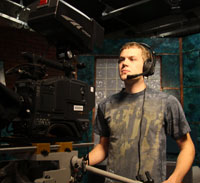Studio time
Studio time

Then the set - in shades of aqua and gray with a glass-block wall behind the interview space - comes alive. Rows of bright overhead lights flash on. Student camera operators with headsets take cues from a director in the control room, his eyes on monitors and hands on a video switcher.
"Gimme a close-up," the director calls to Camera 1 and the operator complies. "Now give me a two-shot," TV vernacular for opening up the frame so two subjects are on-screen at once.
For Radio, Television, Film majors in Rowan's College of Communication, this $400,000 studio, designed by the same firm that created world-famous sets for CNN and MSNBC, is nirvana - a laboratory experience in which to develop technique on professional-quality equipment.
But it isn't just practice. RTF students, many of whom are active in the Rowan Television Network and other extra-curricular activities, produce award-winning programs in this space and use it as a springboard to full-time gigs.
"The studio was designed by professionals so you get the experience of using the same equipment as you will in your career," said junior Adam Bradshaw, president of the Rowan Television Network, an award-winning club that produces original content for on-campus broadcasts.
Bradshaw, 21, of Kalamazoo, Mich., said he came east specifically for Rowan's RTF program.
"I was interested in Rowan for a number of reasons," said Bradshaw, an aspiring TV and film producer. "First of all, there's the location - in between Philadelphia, Atlantic City and New York. And the program itself is great."
Equally as important, he said, was undergraduate access to first-rate equipment.
"When you go for an interview for your first job it's a big plus to have that experience because it puts you above other people going for the same job as you," Bradshaw said.
Chris Winkler, Rowan's TV production coordinator who also teaches Television Production, believes the facilities on campus perfectly prepare students for their first job.
"We've tried to echo what our students would find in a small to medium sized market studio which is where most of them will land their first job," he said.
Winkler said the four-camera set-up in Studio 2 compliments the older but very flexible space just next door in Studio 1.
"Studio 1 is our all-purpose room," he said. "As opposed to
Studio 2, where we have actual walls, Studio 1 is an open space
where we use curtains as backdrops. It's a large space and also the
most acoustically dead space in the building. There's no reverb, no
echo, so it's great for audio recordings."
He said Studio 2, which was built with funding through a 2005 New
Jersey Equipment Leasing Fund grant, was created by KLA Design, a
firm that worked with CNN and MSNBC on designing their sets.
Studio engineer Carl Frandino said quality equipment and a
professionally-designed set isn't just window dressing - they
enable students to get experience to help launch careers.
"What this facility allows is for students to choose how they want
to progress in a specific area," Frandino said. "We have plenty of
equipment for them to get their hands on."
Some of the many pieces of professional equipment Rowan's RTF
majors use every day include:
- Hitachi Z-3000W studio cameras
- Panasonic SDX900 DVCPro50 ENG camera
- Panasonic DVCPro VTRs
- Echolab MVS6 Video Switcher
- Soundcraft Series 15 Audio Console
- Harris Inscriber CG Xtreme Broadcast Graphics system
- GlobalStreams Globecaster Studio 8000 Production System
- ETC Expression Lighting Control and ETC Sensor+ Dimming System
- Over 50 Desisti, Lowel, Arri, and ETC lighting fixtures